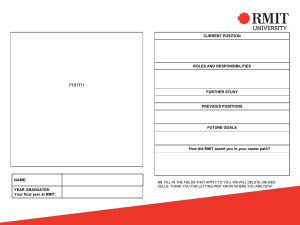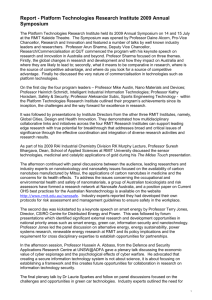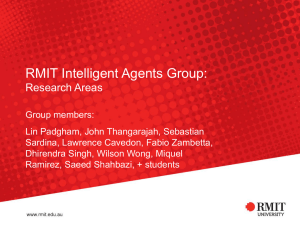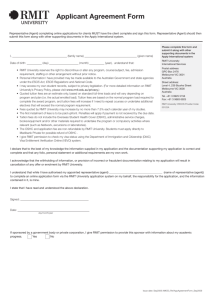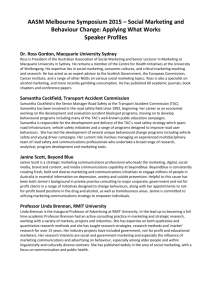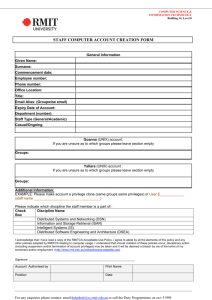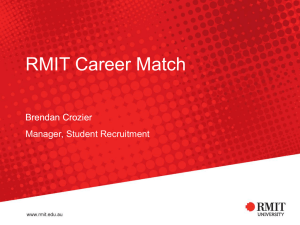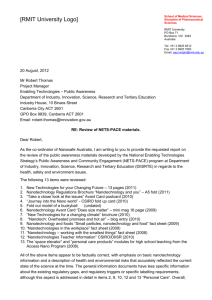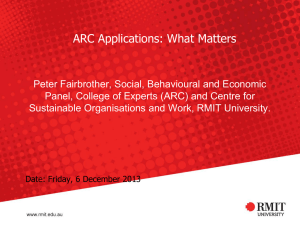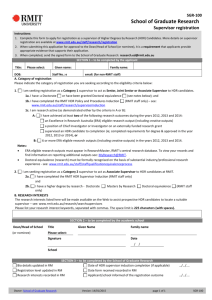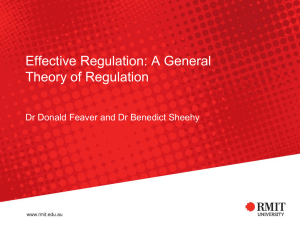Child support compliance in Australia: Are children*s best interests
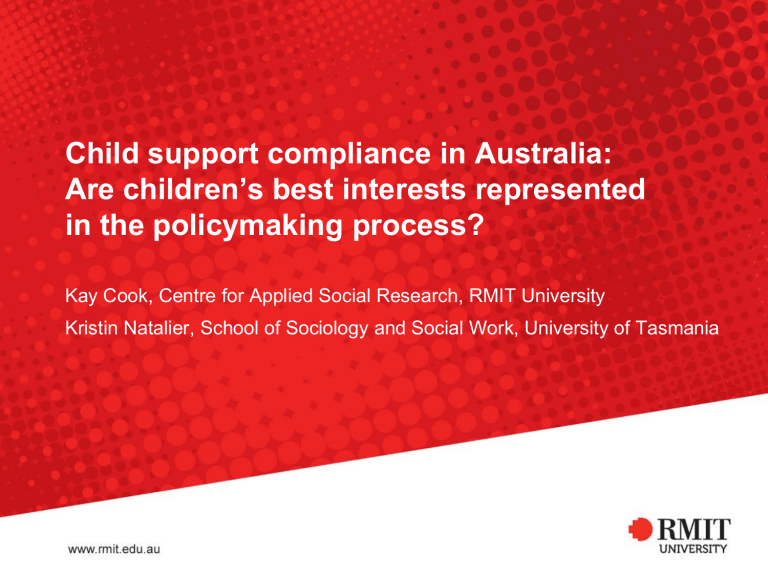
Child support compliance in Australia:
Are children’s best interests represented in the policymaking process?
Kay Cook, Centre for Applied Social Research, RMIT University
Kristin Natalier, School of Sociology and Social Work, University of Tasmania
An overview of the Australian child support system
• Child support impacts 1.5 million separated parents and 1.1 million children in Australia
• Child support was introduced in 1988 to reduce the poverty experienced by women and children after relationship dissolution
– The minimum payment was $5/week. It is now approximately $7/week
– In 2009, there was an outstanding debt of approximately $1 billion in unpaid child support liabilities
– Women and children are still often living in poverty
• Most paying parents are men (85%) and most recipient parents are women
RMIT University © 2012
Centre for Applied Social Research 2
Public acceptance of the scheme
• Child support is one of the most complained about social policies in
Australia, particularly by non-resident parents
– Paying parents claim:
– they pay too much
– money is used by the resident parent rather than on children
– Payee parents claim:
– minimum payments are inadequate
– compliance is poor
• Numerous government reviews have occurred, resulting in extensive legislative changes to the child support scheme between 2006 and
2008 and ongoing compliance reforms
• Some feminist researchers have claimed that men’s rights groups heavily influenced the recent child support reform process, whereas other researchers have denied this claim
RMIT University © 2012
Centre for Applied Social Research 3
Children and child support policy research
• A review of child support research over the last decade found that
“children are rarely discussed and are even less often placed at the centre of the research” (Cook, McKenzie, Knight 2011, p. 123)
• The majority of Australian child support research focuses on:
– whether parents share equitably in supporting their children
– whether the level of support is adequate re the costs of children
• While international research exists (Ridge 2005), only one Australian study has examined outcomes for children (Cook et al 2008)
– For children in low income single parent families, receiving less child support than expected predicted:
– worse school functioning
– more conduct problems
– less involvement in social activities
RMIT University © 2012
Centre for Applied Social Research 4
UN Convention on the Rights of the Child
Article 18.1
•
States Parties shall use their best efforts to ensure recognition of the principle that both parents have common responsibilities for the upbringing and development of the child . Parents or, as the case may be, legal guardians, have the primary responsibility for the upbringing and development of the child. The best interests of the child will be their basic concern.
Article 26.1
• States Parties shall recognize for every child the right to benefit from social security , including social insurance, and shall take the necessary measures to achieve the full realization of this right in accordance with their national law.
Article 27.4
• States Parties shall take all appropriate measures to secure the recovery of maintenance for the child from the parents or other persons having financial responsibility for the child , both within the State Party and from abroad…
RMIT University © 2012
Centre for Applied Social Research 5
Child Support Agency 2010 – 2012 compliance strategy
• Factors affecting payer’s motivation to meet their child support responsibilities
(p. 4):
– Relationship between parents
– Relationship with children
– Attitude to the Child Support Scheme
– Financial situation
• Approach to child support debt:
– First missed payment: Contact the payer and discus reasons and provide assistance
– Where a parent falls behind: “make every possible attempt to contact them and negotiate an appropriate and sustainable payment arrangement” (p. 6)
• This framing legitimises men’s financial autonomy (men’s right to choose)
RMIT University © 2012
Centre for Applied Social Research 6
Recent child support reforms
2003 Inquiry
RMIT University © 2012
2005 Taskforce
2006 – 08
Legislation
2010 Compliance program
Centre for Applied Social Research 7
2003 Inquiry: Recommendation 25
Recommendation
1.
Reducing the cap on payer parent’s assessable income
2. Eliminating the link between contact and child support liabilities
3. Amending the calculation of child support on overtime and second jobs
4. Increasing prescribed non-agency (in-kind) payments from 25% to 30%
2005 –
2006/08
Trajectory
Realised
5. Increase minimum liability from $260 to
$520 per year
Amended
Who stood to benefit?
Payers
Payees
Source: Cook K & Natalier K. (2011). The gendered framing of Australia’s child support reforms. Conference Proceedings of The Australian
Sociological Association 2011 Conference , Newcastle, NSW: TASA .
RMIT University © 2012
Centre for Applied Social Research 8
2003 Inquiry: Recommendation 25 - compliance
Recommendation Trajectory Who stood to benefit?
Payees 6. Amending CSA enforcement powers:
• Notified of insurance settlements
• Collect from realised superannuation
•
Access joint bank accounts
• Use credit reference information
• Determine transfer of assets
• Access lump sum payments
• Collect child support from non-wage earners
Abandoned
7. Cancel drivers/other licences for payers with arrears
Rejected Payees
Source: Cook K & Natalier K. (2011). The gendered framing of Australia’s child support reforms. Conference Proceedings of The Australian
Sociological Association 2011 Conference , Newcastle, NSW: TASA .
RMIT University © 2012
Centre for Applied Social Research 9
Abandoned recommendations
• Debt recovery presented as necessary to provide payees with ‘an important part of their household income’
RMIT University © 2012
• Enforcement not included in
Taskforce TORs
• Women’s hardship removed; focus on
‘public confidence in the Scheme’
• Recommended many govt benefits be garnisheed
• Improved enforcement was abandoned
• Garnisheeing applied only to payments where government already had a direct role (DVA and
Centrelink pensions)
• Payees can take private action
Centre for Applied Social Research
• No substantial amendments made to the third party collection provisions in the Act since their introduction in 1992
• No regulatory or practical mechanisms introduced to identify such third parties
10
Rejected recommendation
• Cancel drivers and other licences of payers with outstanding child support liabilities
RMIT University © 2012
• Counselled against this option as it
‘might reduce
[payer] parents’ capacity to earn income’
(p. 178)
• Not addressed
Centre for Applied Social Research
• Not addressed
11
Sources of income for a payee with 80% care
100.00
90.00
80.00
70.00
60.00
50.00
40.00
30.00
20.00
10.00
0.00
2/
3
M
TA
W
E
$5
0,
00
0
$5
5,
00
0
$6
0,
00
0
$6
5,
00
0
$7
0,
00
0
$7
5,
00
0
$8
0,
00
0
$8
5,
00
0
$9
0,
00
0
$9
5,
00
0
$1
00
,0
00
Parenting Payment (Single)
Family Tax Benefit (Part B)
Family Tax Benefit (Part A)
Rent Assistance
Child support
Conclusions
• Current compliance measures and existing child support legislation has done little to improve children’s material living standards
• Child support compliance and legislation seems bound to men’s financial autonomy
• It may be again time to examine the Child Support Scheme from the perspective of children to ensure that their rights are being upheld
RMIT University © 2012
Centre for Applied Social Research 13
